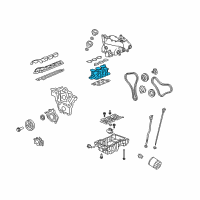< Back ×
2008 Cadillac CTS Intake Manifold
My Vehicle Change Vehicle
2008 Cadillac CTS
< Back to View All
Air Filters & Intake Systems
- Department
- Prices
- Product Specifications
- Notes: Cts; 3.6l
- Other Names: Intake Manifold
- Item Dimensions: 7.2 x 7.1 x 15.9 inches
- Item Weight: 6.20 Pounds
- Fitment Type: Direct Replacement
- Replaces: 92068635, 12571079
- Part Description: Intake Manifold
FAQ for Intake Manifold Repair
Q: How to remove the Intake Manifold?
A:
First, you need to remove the fuel injector sight shield and the air outlet duct, disconnect the brake booster vacuum hose, the purge solenoid valve electrical connector, and the purge line. Then, please remove the wiring harness retainer, disconnect the throttle body electrical connector, remove the upper intake manifold brace stud, bolt, and brace, disconnect the positive crankcase ventilation (PCV) hose, the barometric pressure sensor electrical connector, and the intake manifold runner control solenoid electrical connector. Finally, you should remove the injector harness bracket bolt, the left bank ignition coil wiring harness, the upper intake manifold bolts, and the upper intake manifold with the throttle body.
By Bob
GM Specialist
01/11/2022Q: How to remove the Upper Intake Manifold (LP1, LY7)?
A:
First, you need to remove the fuel injector sight shield, and the air outlet duct and disconnect the brake booster vacuum hose from the intake manifold and the power steering booster pump. Then, please remove the purge solenoid valve bracket, disconnect the purge line from the intake manifold, remove the throttle body harness electrical harness retainer, disconnect the throttle body electrical connector, remove the intake manifold brace bolts, the intake manifold brace and disconnect the positive crankcase ventilation (PCV) hose from the intake manifold. Finally, you should unclip the engine harness from the left side of the intake manifold, remove the intake manifold rear heat shield bolts, remove the intake manifold bolts, and the intake manifold with the throttle body. If the intake manifold is being replaced, you should disassemble the intake manifold.
By Bob
GM Specialist
01/11/2022Q: How to remove the Lower Intake Manifold (LP1, LY7)?
A:
First, you need to remove the fuel injector sight shield, and the air outlet duct, note the booster hose routing and disconnect the brake booster check valve and hose from the brake booster. Then, please reposition the brake booster hose to the intake manifold, disconnect the purge solenoid valve electrical connector, the purge line, the fuel injector harness electrical connector, and the throttle body electrical connector, and remove the wiring harness retainer, upper intake manifold brace stud and bolt, reposition the brace with the wiring harness and remove the wiring harness retainer from the right side of the throttle body. Finally, you should disconnect the positive crankcase ventilation (PCV) hose from the right bank camshaft cover, disconnect the barometric pressure sensor electrical connector, disconnect the intake manifold runner control solenoid electrical connector, remove the left bank ignition coil wiring harness from the bracket, remove the intake manifold bolts and reposition the intake manifold to gain access to the fuel pipe connector.
By Bob
GM Specialist
01/11/2022Q: What is the recommended torque for the upper intake manifold bolts?
A:
The recommended torque is 23 N.m (17 lb-ft).
By Bob
GM Specialist
01/11/2022
